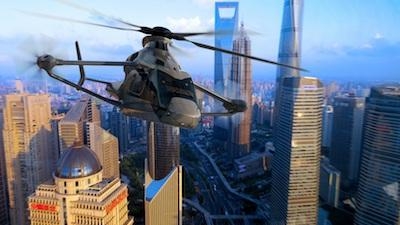Wed, Jun 21, 2017
Project Developed In The Frame Of Clean Sky 2 Research Program
Airbus Helicopters has unveiled the aerodynamic configuration of the high speed demonstrator it is developing as part of the Clean Sky 2 European research program at the Paris air show. Codenamed Racer, for Rapid And Cost-Effective Rotorcraft, this demonstrator will incorporate a host of innovative features and will be optimised for a cruise speed of more than 400 km/h. It will aim at achieving the best trade-off between speed, cost-efficiency, sustainability and mission performance. Final assembly of the demonstrator is expected to start in 2019, with a first flight the next year.

“Today we unveil our bold vision for the future of high-speed rotorcraft,” said Guillaume Faury, Airbus Helicopters CEO. “This new project, pulling together the skills and know-how of dozens of European partners through the Clean Sky 2 initiative, aims to bring increased speed and range at the right cost, thanks to a simple, safe and proven aerodynamic formula. It will pave the way for new time-sensitive services for 2030 and beyond, setting new benchmarks for high-speed helicopter transportation. ”The Racer demonstrator will be built around a simple architecture, ensuring safety and cost-efficiency. An innovative “box-wing” design, optimised for aerodynamic efficiency, will provide lift in cruise mode while isolating passengers during ground operations from the “pusher” lateral rotors designed to generate thrust in forward flight.
Optimised for performance and low acoustic signature, these lateral rotors as well as the main rotor will be driven by two RTM322 engines. An “eco mode” will be tested by the engine manufacturer to demonstrate an electrically-powered “start and stop” of one engine in flight, thus generating fuel savings and increasing range. The Racer demonstrator will also benefit from a hybrid metallic-composite airframe, specifically designed for low weight and low recurring costs. It will also be equipped with a new high voltage direct current electrical generation, which will significantly contribute to weight reduction.
Building upon the success of the self-funded X3 demonstrator, which validated the “compound” aerodynamic configuration – a combination of a traditional main rotor and innovative lateral rotors – the Racer project will bring this concept closer to an operational design and demonstrate its suitability for a wide spectrum of missions where increased speed and efficiency will bring significant added value for citizens and operators. This is especially the case for emergency medical services and search and rescue operations, as well as for public services, commercial air transport and private and business aviation.
(Image provided with Airbus Helicopters news release)
More News
From 2021: The Inside Skinny On What Being An ANN Oshkosh Stringer Is All About By ANN Senior Stringer Extraordinare, Gene Yarbrough The annual gathering at Oshkosh is a right of p>[...]
Video Showed That During The Takeoff, The Nose Baggage Door Was Open On May 10, 2025, about 0935 eastern daylight time, a Piper PA-32RT-300, N30689, was destroyed when it was invol>[...]
Get The Latest in Aviation News NOW on Instagram Are you on Instagram yet? It's been around for a few years, quietly picking up traction mostly thanks to everybody's new obsession >[...]
"I think what is key, we have offered a bonus to air traffic controllers who are eligible to retire. We are going to pay them a 20% bonus on their salary to stay longer. Don't reti>[...]
Aero Linx: Pilot Briefing The gathering, translation, interpretation, and summarization of weather and aeronautical information into a form usable by the pilot or flight supervisor>[...]
 Oshkosh Memories: An Aero-News Stringer Perspective
Oshkosh Memories: An Aero-News Stringer Perspective NTSB Prelim: Piper PA32RT
NTSB Prelim: Piper PA32RT ANN FAQ: Follow Us On Instagram!
ANN FAQ: Follow Us On Instagram! Aero-News: Quote of the Day (05.28.25)
Aero-News: Quote of the Day (05.28.25) ANN's Daily Aero-Term (05.28.25): Pilot Briefing
ANN's Daily Aero-Term (05.28.25): Pilot Briefing



